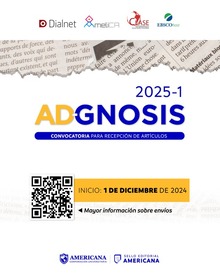Survey on dynamic capabilities
DOI:
https://doi.org/10.21803/adnogsis.v6i6.188Keywords:
Capacidades dinámicas, Absorción, Innovación, Aprendizaje, Adaptación, Explotación del conocimiento, EmpresarialAbstract
The dynamic capabilities are the potential of the company to methodically solve the obstacles constituted by the occasions and warnings to take timely judgments, oriented to the market to change the foundations of its resources. It can deal with a wide variety of fields and variations or renewals of the dynamic capabilities applied at the enterprise level. This article focuses on a review of several dynamic capacities that are frequently used in the business environment and the possibility of generating others from existing ones. There is a wide variety of DC (dynamic capabilities) that can be used as absorption, knowledge exploitation, innovation, learning, knowledge combination, knowledge generation and creation of new capabilities, etc. This paper also deals with a study on some of these commonly used techniques that are being widely used.
Downloads
References
Acosta Prado, J. C., Longo-Somoza, M. & Fischer, A. (2013). Capacidades dina?micas y gestio?n del conocimiento en nuevas empresas de base tecnolo?gica. Cuad. admon.ser.organ., 26(47): 35-62.
Adler, P. & Shenbar, A. (1990). Adapting your technological base: the organizational. Sloan Management Review, 25-37.
Barney, J. (2001). Is the resource-based “view” a useful perspective for strategic management research? Yes. Academy of Management Review, 41-56.
Barney, J. B. (1991). Firm resources and sustained competitive advantage. Journal of Management, 17, 99-120.
Becerra, C. & Palacios, M. (2013). Disen?o de un modelo con enfoque de ge?nero para la medicio?n de capacidades de innovacio?n empresariales: aplicacio?n a Boyaca?. Criterio Libre, 11(19), 281-308. ISSN 1900- 0642.
Benner, M. & Tushman, M. (2003). Exploitation, Exploration, and Process Management: The Productivity Dilemma Revisited. The Academy of Management Review, 28(2), 238-256.
Chakravarthy, B. (1982). Adaptation: A Promising Metaphor for Strategic Management. Academy of Management Review, 7(1), 35-44.
Cohen, W. & Lenvinthal, D. (1990). Absorptive capacity: A new perspective on learning and innovation. Administrative Science Quarterly, 128-152.
Cruz, J. (2010). Concepto e implicaciones de las capacidades dina?micas desde un enfoque de direccio?n del conocimiento. Universidad Complutense de Madrid, Facultad de Ciencias Econo?micas y Empresariales.
Danneels (2002). The dynamics of product innovation and firm competences. Strategic Management Journal, 23(Issue 12), 1095-1121.
Dosi, G., Nelson, R. & Winter, S. (2000). The nature and dynamics of organizational. Oxford University Press.
Eisenhardt, K. & Martin, J. (2000). Dynamic capabilities: What are they? Strategic Management Journal, 11.
Echavarri?a, C. O. (2015). E?tica privada y la Responsabilidad Social Empresarial en las organizaciones financieras de la ciudad de Medelli?n. Ad-Gnosis, 2(2), 225-240.
Ellonen, E. (2011). The role of dynamic capabilities in developing innovation-related capabilities. The Lappeenranta University of Technology.
Ferna?ndez Jardo?n, C. M. (2012). Determinantes de la capacidad de innovacio?n en pymes regionales. Rev. USFM, 5, 749-766.
Finger, M. & Brand, S. (1999). The concept of the learning organization applied to the transformation of the public sector: conceptual contributions of theory development. In Organizational learning and the learning organizations. London: Sage Publications Ltd.
Garzo?n Castrillo?n, M. A. (2015). Modelo de capacidades dina?micas. Revista Dimensio?n Empresarial, 13(1), 111-131. doi: http:// dx.doi.org/10.15665/rde.v13i1.341
Garzon, Castrillon. M. A. (2016). El desarrollo de capacidades dina?micas en las organizaciones. Obtenido de innovacion abier- ta: http://www.innovacionabierta.com.co/profiles/blogs/el-desarrollo-de-capacidades-dinamicas-en-las-organizaciones
Giancarlo (2014). Juego para desarrollar la ca- pacidad de adaptacio?n al cambio. http://www.actuacoaching.com/2014/12/13/ juego-para-desarrollar-la-capacidad-de-adaptacion-al-cambio/
Helfat, C. & Peteraf, M. A. (2003). The dynamic resource-based view: Capability lifecycles. Strategic Management Journal, 24(Issue 10), 997-1010.
Hurtado de Barrera, J. (2012). Metodologi?a de la investigacio?n. Bogota?-Caracas: Quiro?n.
Kim, L. (1997). Imitation to innovation: The dynamics of Korea’s technological learning. Cambridge, Massachusetts: Harvard Business Press.
Lane, P. & Lubatkin, M. (1998). Relative absorptive capacity and interorganizational learning. Strategic Management Journal, 19(Issue 5), 461-477.
Lloyd-Reason, L. (2002). Innovation and Educational Policy in SMEs: A Czech Perspective. Education + Training, 44(Issue 8/9), 378-387.
March, J. G. (1991). Exploration and exploitation in organizational learning. Organization Science, 2(1), 71-87.
Palomares, L. & Mertens, L. (2006). Capacidades Dina?micas de Aprendizaje en las Organizaciones. Seminario Internacional globalizacio?n, crecimiento y desarrollo. UNAM, Me?xico.
Molina, H. (1995). La innovacio?n tecnolo?gica y sus implicaciones estrate?gicas: un enfoque descriptivo. Alicante: Instituto de Cultura.
Nelson, R. R. (1991). Why do firm differ and how does it matter? Strategic Management Journal, 12(Issue 52), 61-74.
Nelson, R. R. & Winter, S. G. (1982). An evolutionary theory of economic change. Harvard University Press.
Nicolau-Julia, D., Exposito-Langa, M. & Tomas-Miquel, J. (2015). Exploracio?n y explotacio?n de conocimiento en el a?mbito empresarial. Validacio?n de escalas en un sector industrial de bajo perfil. Investigaciones Europeas de Direccio?n y Economi?a de la Empresa, 139-147.
Ortega, A., Garci?a, T. & Santos, M. (2012). El desarrollo de nuevos productos a la luz ya la sombra de las capacidades dina?mi- cas. Cuadernos de Administracio?n, 113- 135.
Radas, S. & Bozic, L. (2009). The antecedents of SME innovativeness in an emerging transition economy. Technovation, 6-7.
Schumpeter, J. A. (1961). A Theoretical, Historical, and Statistical Analysis of the Capitalist Process. New York: Go?ttingen.
Teece, D. J. (2007). Explicating dynamic capabilities. The nature of micro foundations of (sustainable) enterprise performance. Strategic Management Journal, 28, 1319-1350.
Torras Arruga, L. (1997). Aprender: la ventaja competitiva ma?s sostenible en el tiempo. Alta Direccio?n, 13-19.
Tugendhat (2001). Identidad Chilena. Santiago de Chile: LOM ediciones.
Uotila, J. & Maula, M. (2009). Exploration, Exploitation, and Financial Performance: Analysis of S&P 500 Corporations. Stra- tegic Management Journal, 221-231.
Vivas-Lo?pez, S. (2005). Competitive advantage and strategy formulation: The key role of dynamic capabilities. Management Decision, 540-557.
Vivas-Lo?pez, S. (2013). Implicaciones de las capacidades dina?micas para la compe- titividad y la innovacio?n en el siglo XXI. Cuadernos de Administracio?n, 26(47).
Wang, C. L. & Ahmed, P. K. (2007). Dynamic capabilities: A review and research agenda. International Journal of Management Reviews, 31-51.
Winter, S. G. (2003). Understanding dynamic capabilities. Strategic Management Journal, 991-995.
Zahra, S. & George, G. (2002). The net-enabled business innovation cycle and the evolution of dynamic capabilities. Information Systems Research, 147-150.
Downloads
Published
Versions
- 2023-01-26 (2)
- 2017-12-08 (1)
Issue
Section
License
Copyright (c) 2023 AD-GNOSIS

This work is licensed under a Creative Commons Attribution-NonCommercial-NoDerivatives 4.0 International License.






